Regular Wave Seakeeping Analysis of a Planing Hull by Smoothed Particle Hydrodynamics: A Comprehensive Validation
Abstract
1. Introduction
2. The SPH Method
2.1. Mathematical Fundamentals
2.2. Governing Equations
2.3. Rigid Body Dynamics and SPH
2.4. Boundary Conditions
3. Experimental Layout
4. Numerical Implementation
4.1. Derivation of the Flow Field
4.2. DualSPHysics Framework
5. Results
5.1. Roll Decay Test
- Single-DOF numerical roll tests show faster decay terms with respect to multiple-DOF results [67], as the complete reproduction of the complex and non-linear phenomenon is impossible to achieve through strict motion assumptions;
- The SPH resolution strongly influences the results as the motion amplitude decreases, causing a noticeable increase in the numerical damping when the arc covered by the hull approaches the dp value [42].
5.2. Waves over Steady Current
5.3. Hull Motions
5.4. Overall Performance
- (a)
- The vessel approaches the incoming wave and the lift forces increase—the keel is almost completely wetted;
- (b)
- The hull’s bow raises after the large hydrodynamic forces toward the maximum trim angle, and the wetted surface tends to its minimum;
- (c)
- The wave trough approaches as the vessel bow is completely lifted, and the water–keel interface is minimized;
- (d)
- The gravitational force guides the hull downward right before the next wave crest, causing its slamming and a consequential sudden increase in pressure on the keel panels, particularly in the chine regions.
6. Conclusions
Author Contributions
Funding
Institutional Review Board Statement
Informed Consent Statement
Data Availability Statement
Conflicts of Interest
Abbreviations
| 2D | Two-Dimensional |
| 3D | Three-Dimensional |
| CFD | Computational Fluid Dynamics |
| DBC | Dynamic Boundary Condition |
| DOF | Degree of Freedom |
| FR | Frame of Reference |
| Beam Froude Number | |
| ITTC | International Towing Tank Conference |
| mDBC | Modified Dynamic Boundary Condition |
| NSS | Naples Systematic Series |
| RANS | Reynolds-Averaged Navier–Stokes |
| RAO | Response Amplitude Operator |
| Reynolds Number | |
| RZ | Relaxation Zone |
| SPH | Smoothed Particle Hydrodynamics |
| STL | Standard Triangle Language |
| WCSPH | Weakly Compressible SPH |
References
- Ulstein, T.; Faltinsen, O.M. Two-dimensional unsteady planing. J. Ship Res. 1996, 40, 200–210. [Google Scholar] [CrossRef]
- Ghadimi, P.; Tavakoli, S.; Dashtimanesh, A. Coupled heave and pitch motions of planing hulls at non-zero heel angle. Appl. Ocean. Res. 2016, 59, 286–303. [Google Scholar] [CrossRef]
- De Luca, F.; Pensa, C. The Naples Systematic Series–Second part: Irregular waves, seakeeping in head sea. Ocean. Eng. 2019, 194, 106620. [Google Scholar] [CrossRef]
- Abrate, S. Hull Slamming. Appl. Mech. Rev. 2011, 64, 1003. [Google Scholar] [CrossRef]
- Begovic, E.; Bertorello, C.; Pennino, S. Experimental seakeeping assessment of a warped planing hull model series. Ocean. Eng. 2014, 83, 1–15. [Google Scholar] [CrossRef]
- Fridsma, G. A Systematic Study of the Rough-Water Performance of Planing Boats: Irregular Waves—Part 2; Technical Report; David W. Taylor Naval Ship Research and Development Center; Defense Technical Information Center: Fairfax, VA, USA, 1971.
- Grigoropoulos, G.; Loukakis, T. Resistance and seakeeping characteristics of a systematic series in the pre-planing condition (Part I). Trans. SNAME 2002, 110, 77–113. [Google Scholar]
- Soletic, L. Seakeeping of a Systematic Series of Planing Hulls. Ph.D. Thesis, Stevens Institute of Technology, Hoboken, NJ, USA, 2009. [Google Scholar]
- De Luca, F.; Pensa, C. The Naples warped hard chine hulls systematic series. Ocean. Eng. 2017, 139, 205–236. [Google Scholar] [CrossRef]
- Zarnick, Z.E. A Nonlinear Mathematical Model of Motions of a Planing Boat in Regular Waves; David W. Taylor Naval Ship Research and Development Center; Defense Technical Information Center: Fairfax, VA, USA, 1978. [CrossRef]
- Pennino, S.; Begovic, E.; Bertorello, C.; Scamardella, A. Time domain assessment of vertical motions of planing hulls. In Technology and Science for the Ships of the Future: Proceedings of NAV 2018: 19th International Conference on Ship & Maritime Research, Trieste, Italy, 20–22 June 2018; IOS Press: Amsterdam, The Netherlands, 2018; p. 472. [Google Scholar]
- Kahramanoglu, E.; Pennino, S.; Yilmaz, H. Numerical evaluation of hydrodynamic characteristics of planing hulls by using a hybrid method. Proc. Inst. Mech. Eng. Part M J. Eng. Marit. Environ. 2021, 235, 344–355. [Google Scholar] [CrossRef]
- Bi, X.; Zhuang, J.; Su, Y. Seakeeping Analysis of Planing Craft under Large Wave Height. Water 2020, 12, 20. [Google Scholar] [CrossRef]
- Tavakoli, S.; Niazmand Bilandi, R.; Mancini, S.; De Luca, F.; Dashtimanesh, A. Dynamic of a planing hull in regular waves: Comparison of experimental, numerical and mathematical methods. Ocean. Eng. 2020, 217, 107959. [Google Scholar] [CrossRef]
- Tezdogan, T.; Demirel, Y.K.; Kellett, P.; Khorasanchi, M.; Incecik, A.; Turan, O. Full-scale unsteady RANS CFD simulations of ship behaviour and performance in head seas due to slow steaming. Ocean. Eng. 2015, 97, 186–206. [Google Scholar] [CrossRef]
- Pacuraru, F.; Domnisoru, L.; Pacuraru, S. On the Comparative Seakeeping Analysis of the Full Scale KCS by Several Hydrodynamic Approaches. J. Mar. Sci. Eng. 2020, 8, 962. [Google Scholar] [CrossRef]
- International Towing Tank Conference (ITTC). The Specialist Committee on Model Test of High Speed Marine Vehicles; Final Report and Recommendations to the 22nd ITTC; ITTC: Zürich, Switzerland, 2014. [Google Scholar]
- Rakhsha, M.; Kees, C.E.; Negrut, D. Lagrangian vs. Eulerian: An analysis of two solution methods for free-surface flows and fluid solid interaction problems. Fluids 2021, 6, 460. [Google Scholar] [CrossRef]
- Wang, S.; González-Cao, J.; Islam, H.; Gómez-Gesteira, M.; Guedes Soares, C. Uncertainty estimation of mesh-free and mesh-based simulations of the dynamics of floaters. Ocean. Eng. 2022, 256, 111386. [Google Scholar] [CrossRef]
- Liu, G.; Liu, M. Smoothed Particle Hydrodynamics; World Scientific: Singapore, 2003. [Google Scholar] [CrossRef]
- Monaghan, J.J. Smoothed Particle Hydrodynamics. Annu. Rev. Astron. Astrophys. 1992, 30, 543–574. [Google Scholar] [CrossRef]
- Violeau, D.; Rogers, B. Smoothed particle hydrodynamics (SPH) for free-surface flows: Past, present and future. J. Hydraul. Res. 2016, 54, 1–26. [Google Scholar] [CrossRef]
- Gotoh, H.; Khayyer, A. On the state-of-the-art of particle methods for coastal and ocean engineering. Coast. Eng. J. 2018, 60, 79–103. [Google Scholar] [CrossRef]
- Manenti, S.; Wang, D.; Domínguez, J.; Li, S.; Amicarelli, A.; Albano, R. SPH Modeling of Water-Related Natural Hazards. Water 2019, 11, 1875. [Google Scholar] [CrossRef]
- Amicarelli, A.; Manenti, S.; Albano, R.; Agate, G.; Paggi, M.; Longoni, L.; Mirauda, D.; Ziane, L.; Viccione, G.; Todeschini, S.; et al. 9.0.0: A Computational Fluid Dynamics research code, based on the Smoothed Particle Hydrodynamics mesh-less method. Comput. Phys. Commun. 2020, 250, 107157. [Google Scholar] [CrossRef]
- Luo, M.; Khayyer, A.; Lin, P. Particle methods in ocean and coastal engineering. Appl. Ocean. Res. 2021, 114, 102734. [Google Scholar] [CrossRef]
- Khayyer, A.; Rogers, B.D.; Zhang, A.M. Preface: Special Issue on Advances and Applications of SPH in Ocean Engineering. Appl. Ocean. Res. 2022, 118, 103028. [Google Scholar] [CrossRef]
- Marrone, S.; Colagrossi, A.; Antuono, M.; Lugni, C.; Tulin, M.P. A 2D+t SPH model to study the breaking wave pattern generated by fast ships. J. Fluids Struct. 2011, 27, 1199–1215. [Google Scholar] [CrossRef]
- Marrone, S.; Bouscasse, B.; Colagrossi, A.; Antuono, M. Study of ship wave breaking patterns using 3D parallel SPH simulations. Comput. Fluids 2012, 69, 54–66. [Google Scholar] [CrossRef]
- Dashtimanesh, A.; Ghadimi, P. A three-dimensional SPH model for detailed study of free surface deformation, just behind a rectangular planing hull. J. Braz. Soc. Mech. Sci. Eng. 2013, 35, 369–380. [Google Scholar] [CrossRef]
- Tafuni, A.; Sahin, I.; Hyman, M. Numerical investigation of wave elevation and bottom pressure generated by a planing hull in finite-depth water. Appl. Ocean. Res. 2016, 58, 281–291. [Google Scholar] [CrossRef]
- Brizzolara, S.; Viviani, M.; Savio, L. Comparison of SPH and RANSE methods for the evaluation of impact problems in the marine field. In Proceedings of the 8th World Congress on Computational Mechanics (WCCM8), Venice, Italy, 30 June–4 July 2008. [Google Scholar]
- Cheng, H.; Ming, F.; Sun, P.; Sui, Y.; Zhang, A.M. Ship hull slamming analysis with smoothed particle hydrodynamics method. Appl. Ocean. Res. 2020, 101, 102268. [Google Scholar] [CrossRef]
- Domínguez, J.; Fourtakas, G.; Altomare, C.; Canelas, R.; Tafuni, A.; García Feal, O.; Martínez-Estévez, I.; Mokos, A.; Vacondio, R.; Crespo, A.; et al. DualSPHysics: From fluid dynamics to multiphysics problems. Comput. Part. Mech. 2022, 9, 867–895. [Google Scholar] [CrossRef]
- Domínguez, J.M.; Crespo, A.J.; Gómez-Gesteira, M. Optimization strategies for CPU and GPU implementations of a smoothed particle hydrodynamics method. Comput. Phys. Commun. 2013, 184, 617–627. [Google Scholar] [CrossRef]
- Domínguez, J.; Crespo, A.; Hall, M.; Altomare, C.; Wu, M.; Stratigaki, V.; Troch, P.; Cappietti, L.; Gómez-Gesteira, M. SPH simulation of floating structures with moorings. Coast. Eng. 2019, 153, 103560. [Google Scholar] [CrossRef]
- Martínez-Estévez, I.; Domínguez, J.; Tagliafierro, B.; Canelas, R.; García-Feal, O.; Crespo, A.; Gómez-Gesteira, M. Coupling of an SPH-based solver with a multiphysics library. Comput. Phys. Commun. 2023, 283, 108581. [Google Scholar] [CrossRef]
- Tagliafierro, B.; Montuori, R.; Vayas, I.; Ropero-Giralda, P.; Crespo, A.; Domìnguez, J.; Altomare, C.; Viccione, G.; Gòmez-Gesteira, M. A new open source solver for modelling fluid-structure interaction: Case study of a point-absorber wave energy converter with a power take-off unit. In Proceedings of the 11th International Conference on Structural Dynamics, Athens, Greece, 23–26 November 2020. [Google Scholar] [CrossRef]
- Ropero-Giralda, P.; Crespo, A.J.; Tagliafierro, B.; Altomare, C.; Domínguez, J.M.; Gómez-Gesteira, M.; Viccione, G. Efficiency and survivability analysis of a point-absorber wave energy converter using DualSPHysics. Renew. Energy 2020, 162, 1763–1776. [Google Scholar] [CrossRef]
- Tagliafierro, B.; Martínez-Estévez, I.; Domínguez, J.M.; Crespo, A.J.; Göteman, M.; Engström, J.; Gómez-Gesteira, M. A numerical study of a taut-moored point-absorber wave energy converter with a linear power take-off system under extreme wave conditions. Appl. Energy 2022, 311, 118629. [Google Scholar] [CrossRef]
- Tagliafierro, B.; Martínez-Estévez, I.; Crego-Loureiro, C.; Domínguez, J.; Crespo, A.; Coe, R.; Bacelli, G.; Viccione, G.; Gómez-Gesteira, M. Numerical Modeling of Moored Floating Platforms for Wave Energy Converters Using DualSPHysics. In Proceedings of the 41st International Conference on Offshore Mechanics and Arctic Engineering (OMAE), Hamburg, Germany, 5–10 June 2022; p. 8. [Google Scholar]
- Tagliafierro, B.; Karimirad, M.; Martínez-Estévez, I.; Domínguez, J.M.; Viccione, G.; Crespo, A.J.C. Numerical Assessment of a Tension-Leg Platform Wind Turbine in Intermediate Water Using the Smoothed Particle Hydrodynamics Method. Energies 2022, 15, 3993. [Google Scholar] [CrossRef]
- Tagliafierro, B.; Karimirad, M.; Martínez-Estévez, I.; Domínguez, J.; Crespo, A.; Gómez-Gesteira, M.; Viccione, G. Preliminary study of floating offshore wind turbines motions using the Smoothed Particle Hydrodynamics method. In Proceedings of the 41st International Conference on Offshore Mechanics and Arctic Engineering (OMAE), Hamburg, Germany, 5–10 June 2022; p. 3993. [Google Scholar]
- Mintu, S.; Molyneux, D.; Colbourne, B. Full-scale SPH simulations of ship-wave impact generated sea spray. Ocean. Eng. 2021, 241, 110077. [Google Scholar] [CrossRef]
- Tagliafierro, B.; Mancini, S.; Ropero-Giralda, P.; Domínguez, J.M.; Crespo, A.J.C.; Viccione, G. Performance assessment of a planing hull using the smoothed particle hydrodynamics method. J. Mar. Sci. Eng. 2021, 9, 244. [Google Scholar] [CrossRef]
- Hosseini, A.; Tavakoli, S.; Dashtimanesh, A.; Sahoo, P.K.; Korgesaar, M. Performance Prediction of a Hard-Chine Planing Hull by Employing Different CFD Models. J. Mar. Sci. Eng.G 2021, 9, 481. [Google Scholar] [CrossRef]
- Pak, C.; Han, P.; Ri, K.; Ri, Y.; Hwang, I. Numerical analysis of the nonlinear free surface flow around an advancing ship using moving particle semi-implicit method. AIP Adv. 2021, 11, 035106. [Google Scholar] [CrossRef]
- Tafuni, A.; Domínguez, J.; Vacondio, R.; Crespo, A. A versatile algorithm for the treatment of open boundary conditions in Smoothed particle hydrodynamics GPU models. Comput. Methods Appl. Mech. Eng. 2018, 342, 604–624. [Google Scholar] [CrossRef]
- Siemens, P. STAR-CCM+ User Guide, Version 13.04.; Siemens PLM Software Inc.: Munich, Germany, 2019. [Google Scholar]
- Wendland, H. Piecewise polynomial, positive definite and compactly supported radial basis functions of minimal degree. Adv. Comput. Math. 1995, 4, 389–396. [Google Scholar] [CrossRef]
- Fourtakas, G.; Dominguez, J.M.; Vacondio, R.; Rogers, B.D. Local uniform stencil (LUST) boundary condition for arbitrary 3-D boundaries in parallel smoothed particle hydrodynamics (SPH) models. Comput. Fluids 2019, 190, 346–361. [Google Scholar] [CrossRef]
- Monaghan, J.; Kos, A.; Issa, N. Fluid Motion Generated by Impact. J. Waterw. Port, Coastal, Ocean. Eng. 2003, 129, 250–259. [Google Scholar] [CrossRef]
- Canelas, R.B.; Domínguez, J.M.; Crespo, A.J.; Gómez-Gesteira, M.; Ferreira, R.M. A Smooth Particle Hydrodynamics discretization for the modelling of free surface flows and rigid body dynamics. Int. J. Numer. Methods Fluids 2015, 78, 581–593. [Google Scholar] [CrossRef]
- English, A.; Domínguez, J.; Vacondio, R.; Crespo, A.; Stansby, P.; Lind, S.; Chiapponi, L.; Gómez-Gesteira, M. Modified dynamic boundary conditions (mDBC) for general purpose smoothed particle hydrodynamics (SPH): Application to tank sloshing, dam break and fish pass problems. Comput. Part. Mech. 2022, 9, 911–925. [Google Scholar] [CrossRef]
- Crespo, A.; Gómez-Gesteira, M.; Dalrymple, R. Boundary conditions generated by dynamic particles in SPH methods. Comput. Mater. Contin. 2007, 5, 173–184. [Google Scholar]
- Zhang, F.; Crespo, A.; Altomare, C.; Domínguez, J.; Marzeddu, A.; Shang, S.p.; Gómez-Gesteira, M. DualSPHysics: A numerical tool to simulate real breakwaters. J. Hydrodyn. 2018, 30, 95–105. [Google Scholar] [CrossRef]
- Marrone, S.; Antuono, M.; Colagrossi, A.; Colicchio, G.; Le Touzé, D.; Graziani, G. δ-SPH model for simulating violent impact flows. Comput. Methods Appl. Mech. Eng. 2011, 200, 1526–1542. [Google Scholar] [CrossRef]
- Liu, M.; Liu, G. Restoring particle consistency in smoothed particle hydrodynamics. Appl. Numer. Math. 2006, 56, 19–36. [Google Scholar] [CrossRef]
- Capasso, S.; Tagliafierro, B.; Güzel, H.; Yilmaz, A.; Dal, K.; Kocaman, S.; Viccione, G.; Evangelista, S. A Numerical Validation of 3D Experimental Dam-Break Wave Interaction with a Sharp Obstacle Using DualSPHysics. Water 2021, 13, 2133. [Google Scholar] [CrossRef]
- Brito, M.; Bernardo, F.; Neves, M.G.; Neves, D.R.C.B.; Crespo, A.J.C.; Domínguez, J.M. Numerical Model of Constrained Wave Energy Hyperbaric Converter under Full-Scale Sea Wave Conditions. J. Mar. Sci. Eng. 2022, 10, 1489. [Google Scholar] [CrossRef]
- Bhattacharyya, B. Dynamics of Marine Vehicles; Wiley: New York, NY, USA, 1978. [Google Scholar]
- Dean, R.; Dalrymple, R. Water Wave Mechanics for Engineers and Scientists; Advanced Series on Ocean Engineering; World Scientific Publishing Company: Singapore, 1991. [Google Scholar]
- Fenton, J. Nonlinear Wave Theories. Sea Ocean. Eng. Sci. 1990, 9, 3–25. [Google Scholar]
- Gomez-Gesteira, M.; Rogers, B.; Crespo, A.; Dalrymple, R.; Narayanaswamy, M.; Dominguez, J. SPHysics—Development of a free-surface fluid solver–Part 1: Theory and formulations. Comput. Geosci. 2012, 48, 289–299. [Google Scholar] [CrossRef]
- Ruffini, G.; Domínguez, J.M.; Briganti, R.; Altomare, C.; Stolle, J.; Crespo, A.J.; Ghiassi, B.; Capasso, S.; De Girolamo, P. MESH-IN: A MESHed INlet offline coupling method for 3-D extreme hydrodynamic events in DualSPHysics. Ocean. Eng. 2023, 268, 113400. [Google Scholar] [CrossRef]
- Altomare, C.; Tagliafierro, B.; Dominguez, J.; Suzuki, T.; Viccione, G. Improved relaxation zone method in SPH-based model for coastal engineering applications. Appl. Ocean. Res. 2018, 81, 15–33. [Google Scholar] [CrossRef]
- Mancini, S.; Begovic, E.; Day, A.H.; Incecik, A. Verification and validation of numerical modelling of DTMB 5415 roll decay. Ocean. Eng. 2018, 162, 209–223. [Google Scholar] [CrossRef]
- Altomare, C.; Domínguez, J.; Crespo, A.; González-Cao, J.; Suzuki, T.; Gómez-Gesteira, M.; Troch, P. Long-crested wave generation and absorption for SPH-based DualSPHysics model. Coast. Eng. 2017, 127, 37–54. [Google Scholar] [CrossRef]
- Rota Roselli, R.A.; Vernengo, G.; Altomare, C.; Brizzolara, S.; Bonfiglio, L.; Guercio, R. Ensuring numerical stability of wave propagation by tuning model parameters using genetic algorithms and response surface methods. Environ. Model. Softw. 2018, 103, 62–73. [Google Scholar] [CrossRef]
- Kahramanoğlu, E.; Çakıcı, F.; Doğrul, A. Numerical Prediction of the Vertical Responses of Planing Hulls in Regular Head Waves. J. Mar. Sci. Eng. 2020, 8, 455. [Google Scholar] [CrossRef]
- Lo, E.; Shao, S. Simulation of near-shore solitary wave mechanics by an incompressible SPH method. Appl. Ocean. Res. 2002, 24, 275–286. [Google Scholar] [CrossRef]
- Capasso, S.; Tagliafierro, B.; Martínez-Estévez, I.; Domínguez, J.; Crespo, A.J.C.; Viccione, G. A DEM approach for simulating flexible beam elements with the Project Chrono core module in DualSPHysics. Comput. Part. Mech. 2022, 9, 969–985. [Google Scholar] [CrossRef]
- O’Connor, J.; Rogers, B.D. A fluid–structure interaction model for free-surface flows and flexible structures using smoothed particle hydrodynamics on a GPU. J. Fluids Struct. 2021, 104, 103312. [Google Scholar] [CrossRef]
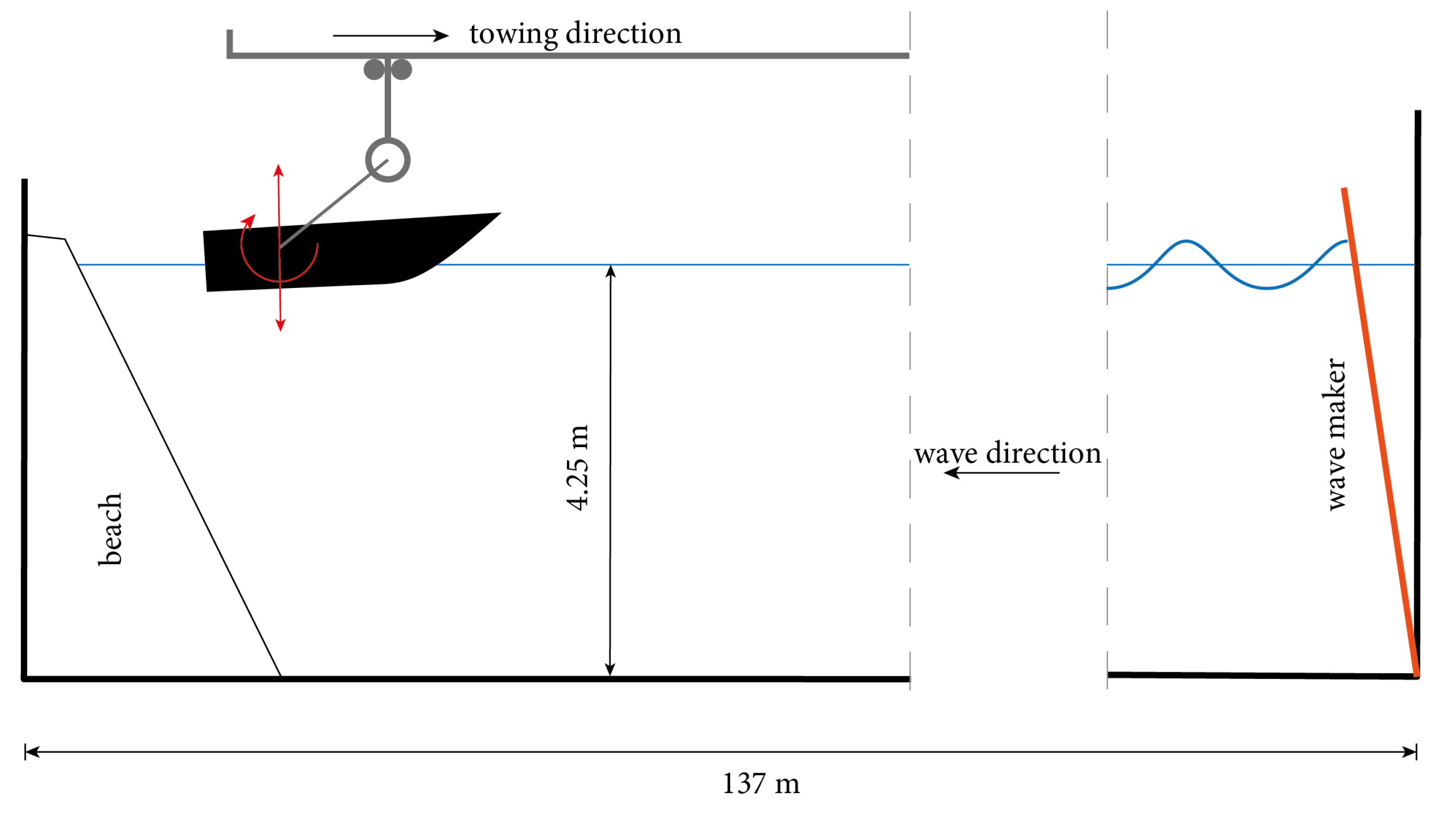
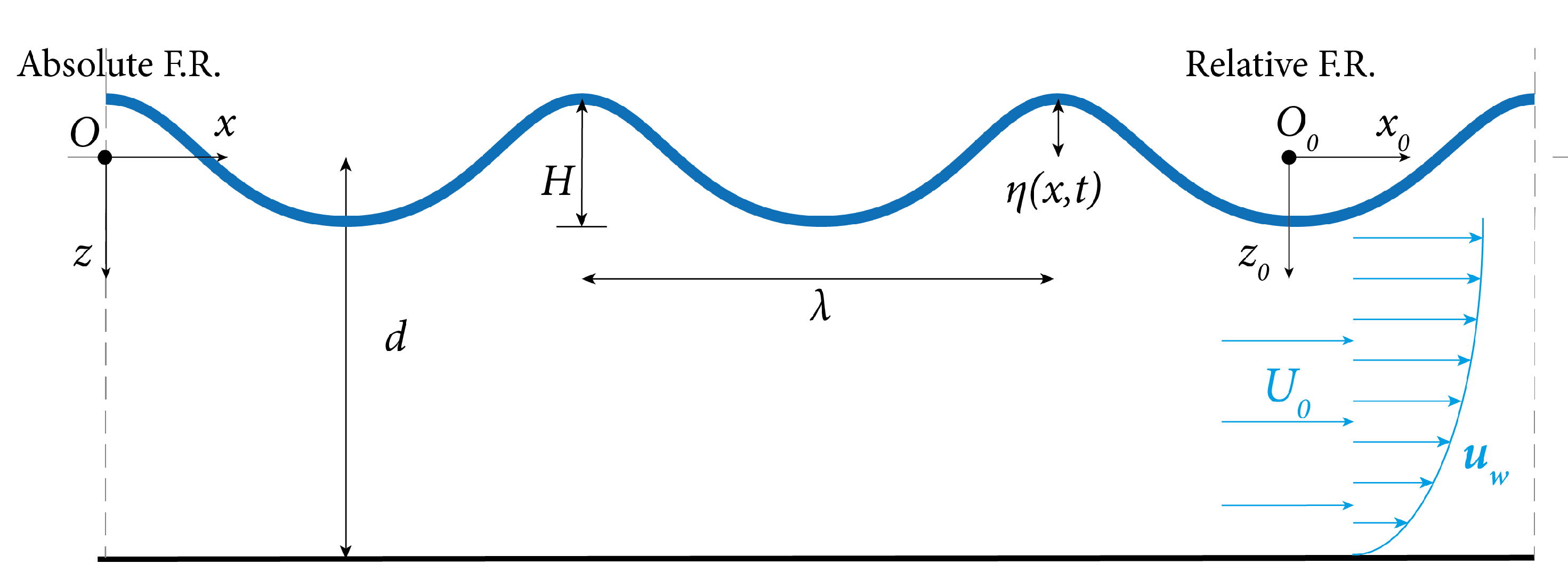

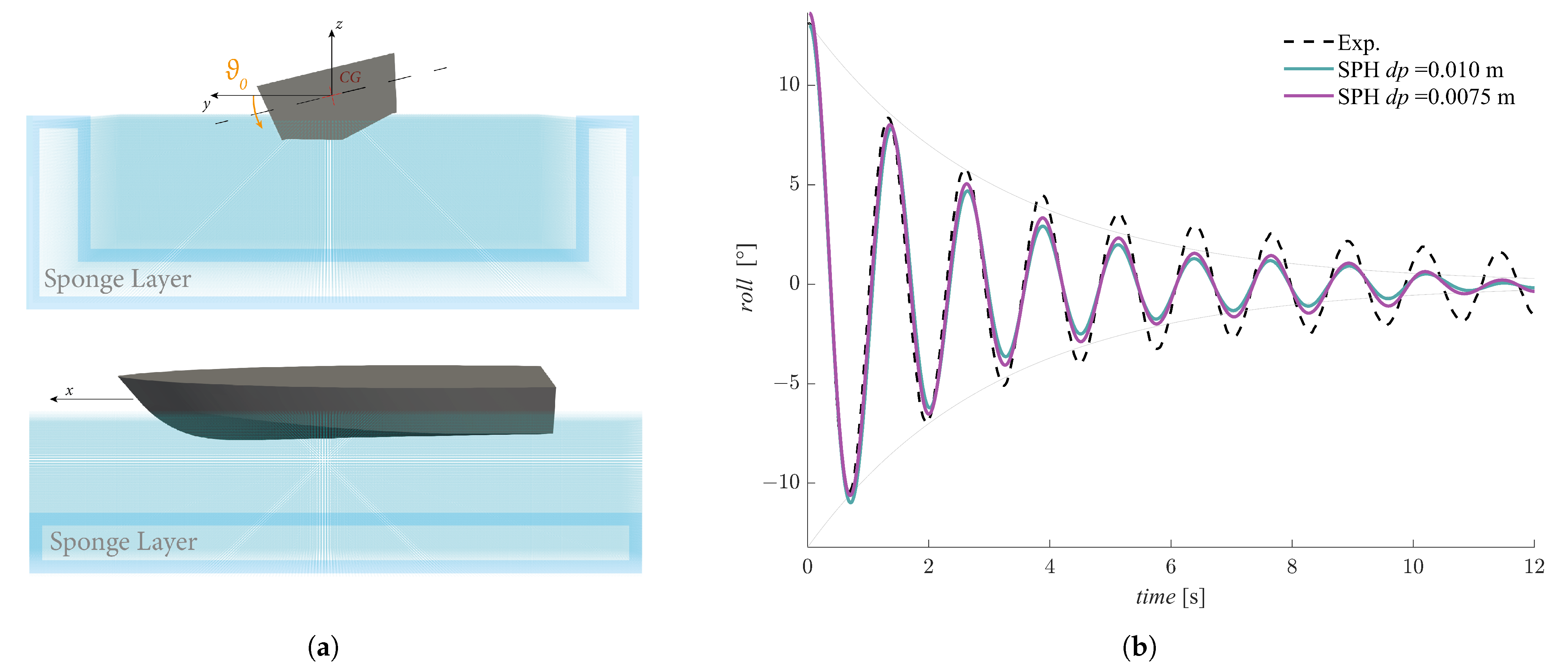


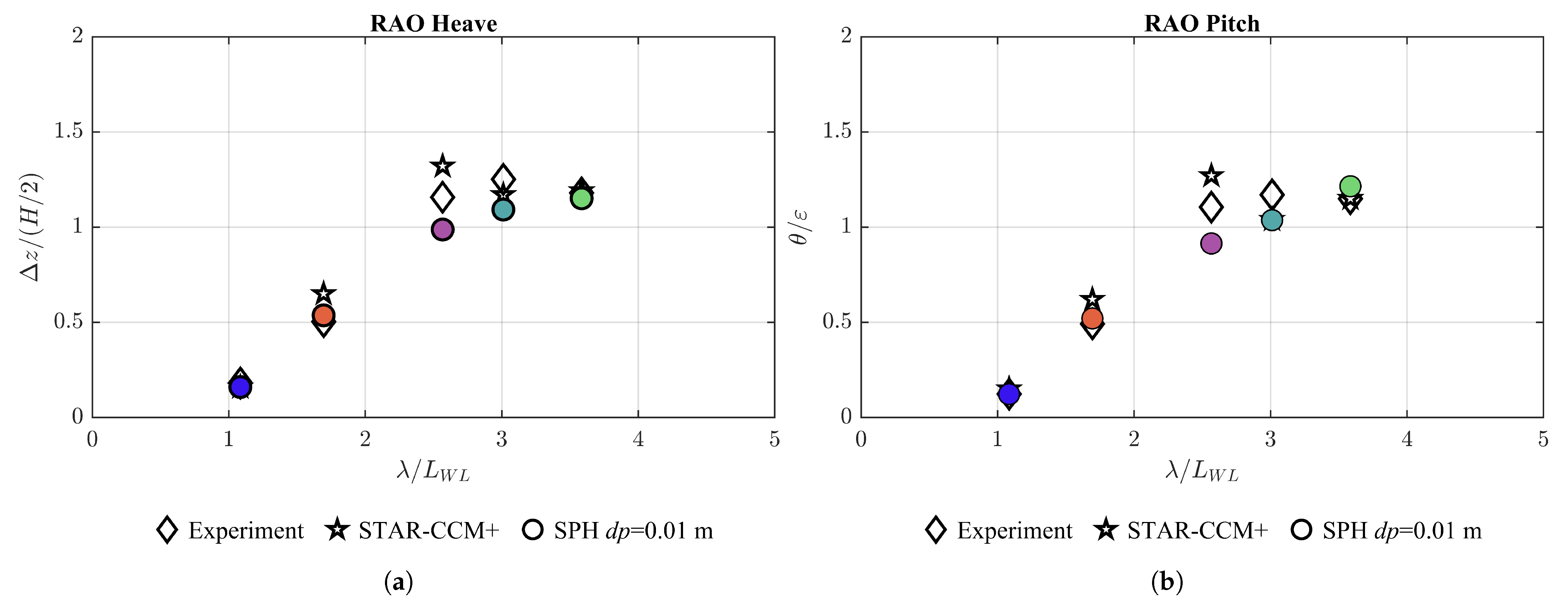
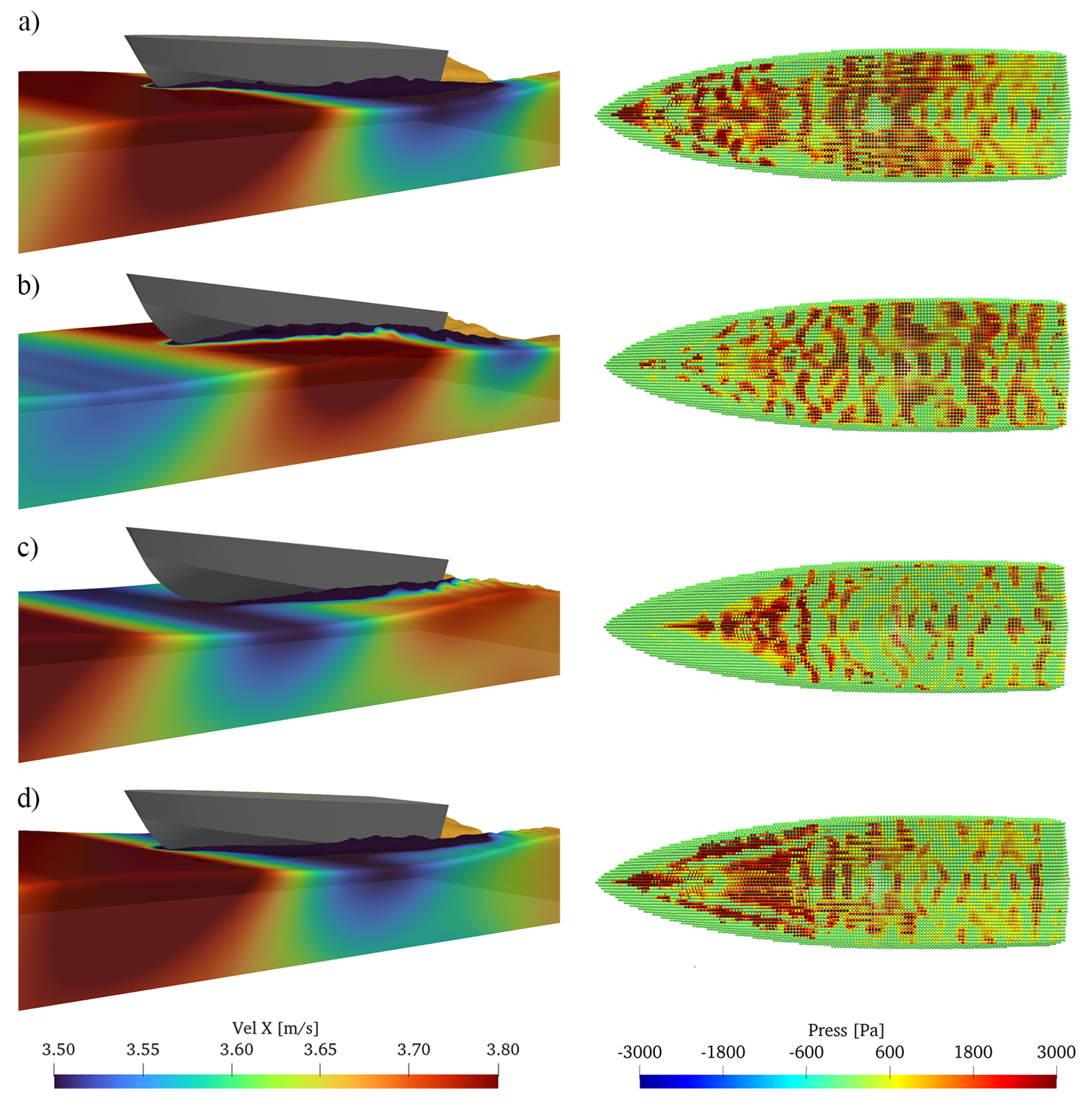
| Dimensions | Unit | C2s Hull | |
|---|---|---|---|
| Length overall | [m] | 1.567 | |
| Length waterline | [m] | 1.440 | |
| Beam | B | [m] | 0.435 |
| Beam waterline | [m] | 0.396 | |
| Longitudinal CG position | [-] | 0.394 | |
| Vertical CG position | [-] | 0.501 | |
| Mass | m | [kg] | 20.91 |
| Roll gyradius | [m] | 0.52 | |
| Pitch gyradius | [m] | 2.79 | |
| Case | Angular Frequency [rad/s] | Wavenumber [1/m] | Relative Wavelength [-] | Amplitude H [m] | Wave Steepness [-] | Water Depth d [m] |
|---|---|---|---|---|---|---|
1  | 3.456 | 1.217 | 3.585 | 0.1035 | 0.063 | 4.25 |
2  | 3.770 | 1.449 | 3.011 | 0.0440 | 0.032 | |
3  | 4.084 | 1.700 | 2.567 | 0.0741 | 0.063 | |
4  | 5.026 | 2.575 | 1.694 | 0.0489 | 0.052 | |
5  | 6.283 | 4.024 | 1.084 | 0.0313 | 0.063 |
| Experimental | ⇒ | Numerical | ||
|---|---|---|---|---|
| Towing velocity | → | Steady current | ||
| Generated frequency | → | Encountered frequency | ||
Exp | RAO Heave STAR-CCM+ [%] | SPH [%] | Exp | RAO Pitch STAR-CCM+ [%] | SPH [%] | |
|---|---|---|---|---|---|---|
3.58  | 1.18 | <1.0 | 1.15 | <1.0 | 5.2 | |
3.01  | 1.25 | 1.17 | ||||
2.57  | 1.16 | 13.8 | 1.10 | 15.4 | ||
1.69  | 0.50 | 30.0 | 8.0 | 0.49 | 26.5 | 6.1 |
1.08  | 0.18 | 0.12 | <1.0 | <1.0 |
Disclaimer/Publisher’s Note: The statements, opinions and data contained in all publications are solely those of the individual author(s) and contributor(s) and not of MDPI and/or the editor(s). MDPI and/or the editor(s) disclaim responsibility for any injury to people or property resulting from any ideas, methods, instructions or products referred to in the content. |
© 2023 by the authors. Licensee MDPI, Basel, Switzerland. This article is an open access article distributed under the terms and conditions of the Creative Commons Attribution (CC BY) license (https://creativecommons.org/licenses/by/4.0/).
Share and Cite
Capasso, S.; Tagliafierro, B.; Mancini, S.; Martínez-Estévez, I.; Altomare, C.; Domínguez, J.M.; Viccione, G. Regular Wave Seakeeping Analysis of a Planing Hull by Smoothed Particle Hydrodynamics: A Comprehensive Validation. J. Mar. Sci. Eng. 2023, 11, 700. https://doi.org/10.3390/jmse11040700
Capasso S, Tagliafierro B, Mancini S, Martínez-Estévez I, Altomare C, Domínguez JM, Viccione G. Regular Wave Seakeeping Analysis of a Planing Hull by Smoothed Particle Hydrodynamics: A Comprehensive Validation. Journal of Marine Science and Engineering. 2023; 11(4):700. https://doi.org/10.3390/jmse11040700
Chicago/Turabian StyleCapasso, Salvatore, Bonaventura Tagliafierro, Simone Mancini, Iván Martínez-Estévez, Corrado Altomare, José M. Domínguez, and Giacomo Viccione. 2023. "Regular Wave Seakeeping Analysis of a Planing Hull by Smoothed Particle Hydrodynamics: A Comprehensive Validation" Journal of Marine Science and Engineering 11, no. 4: 700. https://doi.org/10.3390/jmse11040700
APA StyleCapasso, S., Tagliafierro, B., Mancini, S., Martínez-Estévez, I., Altomare, C., Domínguez, J. M., & Viccione, G. (2023). Regular Wave Seakeeping Analysis of a Planing Hull by Smoothed Particle Hydrodynamics: A Comprehensive Validation. Journal of Marine Science and Engineering, 11(4), 700. https://doi.org/10.3390/jmse11040700










